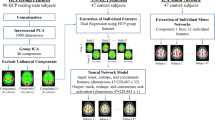Abstract
Resting-state functional MRI (rs-fMRI) has provided important insights into brain physiology. It has become an increasingly popular method for presurgical mapping, as an alternative to task-based functional MRI wherein the subject performs a task while being scanned. However, there is no commonly acknowledged gold standard approach for detecting eloquent brain areas using rs-fMRI data in clinical settings. In this study, a general linear model-based machine learning (GLM-ML) approach was tested to predict individual motor task activation based on rs-fMRI data. Its accuracy was then compared to a conventional independent component analysis (ICA) approach. 47 healthy subjects were scanned using resting state, active and passive motor task fMRI experiments using a clinically applicable low-resolution fMRI protocol. The model was trained to associate rs-fMRI network maps with that of hand movement task fMRI, then used to predict task activation maps for unseen subjects solely based on their rs-fMRI data. Our results showed that the GLM-ML approach can accurately predict individual differences in task activation using rs-fMRI data and outperform conventional ICA to detect task activation in the primary sensorimotor region. Furthermore, the predicted activation maps using the GLM -ML model matched well with the activation of passive hand movement fMRI on an individual basis. These results suggest that GLM-ML approach can robustly predict individual differences of task activation based on conventional low-resolution rs-fMRI data and has important implications for future clinical applications.






Similar content being viewed by others
References
Beckmann, C. F., Mackay, C. E., Filippini, N., & Smith, S. M. (2009). Group comparison of resting-state FMRI data using multi-subject ICA and dual regression. NeuroImage, 47(Suppl 1), S148.
Biswal, B., Zerrin Yetkin, F., Haughton, V. M., & Hyde, J. S. (1995). Functional connectivity in the motor cortex of resting human brain using echo-planar MRI. Magnetic Resonance in Medicine, 34(4), 537–541.
Bizzi, A., Blasi, V., Falini, A., Ferroli, P., Cadioli, M., Danesi, U., et al. (2008). Presurgical functional MR imaging of language and motor functions: validation with intraoperative electrocortical mapping. Radiology, 248(2), 579–589.
Blatow, M., Reinhardt, J., Riffel, K., Nennig, E., Wengenroth, M., & Stippich, C. (2011). Clinical functional MRI of sensorimotor cortex using passive motor and sensory stimulation at 3 tesla. Journal of Magnetic Resonance Imaging, 34(2), 429–437.
Branco, P., Seixas, D., Deprez, S., Kovacs, S., Peeters, R., Castro, S. L., & Sunaert, S. (2016). Resting-state functional magnetic resonance imaging for language preoperative planning. Frontiers in Human Neuroscience, 10, 11.
Cohen, A. D., Chen, Z., Parker Jones, O., Niu, C., & Wang, Y. (2019). Regression-based machine-learning approaches to predict task activation using resting-state fMRI. Human Brain Mapping. https://doi.org/10.1002/hbm.24841.
Cole, M. W., Bassett, D. S., Power, J. D., Braver, T. S., & Petersen, S. E. (2014). Intrinsic and task-evoked network architectures of the human brain. Neuron, 83(1), 238–251.
Damoiseaux, J. S., Rombouts, S., Barkhof, F., Scheltens, P., Stam, C. J., Smith, S. M., & Beckmann, C. F. (2006). Consistent resting-state networks across healthy subjects. Proceedings of the National Academy of Sciences, 103(37), 13848–13853.
DeAngelis, L. M. (2001). Brain tumors. New England Journal of Medicine, 344(2), 114–123.
Duffau, H. (2005). Lessons from brain mapping in surgery for low-grade glioma: insights into associations between tumour and brain plasticity. The Lancet Neurology, 4(8), 476–486.
Field, A. S., Yen, Y.-F., Burdette, J. H., & Elster, A. D. (2000). False cerebral activation on BOLD functional MR images: study of low-amplitude motion weakly correlated to stimulus. American Journal of Neuroradiology, 21(8), 1388–1396.
Giussani, C., Roux, F.-E., Ojemann, J., Sganzerla, E. P., Pirillo, D., & Papagno, C. (2010). Is preoperative functional magnetic resonance imaging reliable for language areas mapping in brain tumor surgery? Review of language functional magnetic resonance imaging and direct cortical stimulation correlation studies. Neurosurgery, 66(1), 113–120.
Glasser, M. F., Sotiropoulos, S. N., Wilson, J. A., Coalson, T. S., Fischl, B., Andersson, J. L., et al. (2013). The minimal preprocessing pipelines for the Human Connectome Project. Neuroimage, 80, 105–124. https://doi.org/10.1016/j.neuroimage.2013.04.127.
Guzzetta, A., Staudt, M., Petacchi, E., Ehlers, J., Erb, M., Wilke, M., Krägeloh-Mann, I., & Cioni, G. (2007). Brain representation of active and passive hand movements in children. Pediatric Research, 61, 485–490. https://doi.org/10.1203/pdr.0b013e3180332c2e.
Johnstone, T., Ores Walsh, K. S., Greischar, L. L., Alexander, A. L., Fox, A. S., Davidson, R. J., & Oakes, T. R. (2006). Motion correction and the use of motion covariates in multiple-subject fMRI analysis. Human Brain Mapping, 27(10), 779–788.
Jones, O. P., Voets, N., Adcock, J., Stacey, R., & Jbabdi, S. (2017). Resting connectivity predicts task activation in pre-surgical populations. NeuroImage: Clinical, 13, 378–385.
Kelly Jr., R. E., Alexopoulos, G. S., Wang, Z., Gunning, F. M., Murphy, C. F., Morimoto, S. S., et al. (2010). Visual inspection of independent components: defining a procedure for artifact removal from fMRI data. Journal of Neuroscience Methods, 189(2), 233–245.
Kim, S. Y., Qi, T., Feng, X., Ding, G., Liu, L., & Cao, F. (2016). How does language distance between L1 and L2 affect the L2 brain network? An fMRI study of Korean–Chinese–English trilinguals. Neuroimage, 129, 25–39.
Kocak, M., Ulmer, J. L., Sahin Ugurel, M., Gaggl, W., & Prost, R. W. (2009). Motor homunculus: passive mapping in healthy volunteers by using functional MR imaging—initial results. Radiology, 251(2), 485–492.
Lee, M. H., Smyser, C. D., & Shimony, J. S. (2013). Resting-state fMRI: a review of methods and clinical applications. American Journal of Neuroradiology, 34(10), 1866–1872.
Liljeström, M., Stevenson, C., Kujala, J., & Salmelin, R. (2015). Task-and stimulus-related cortical networks in language production: exploring similarity of MEG-and fMRI-derived functional connectivity. NeuroImage, 120, 75–87.
McNeill, K. A. (2016). Epidemiology of brain tumors. Neurologic Clinics, 34(4), 981–998.
Mitchell, T. J., Hacker, C. D., Breshears, J. D., Szrama, N. P., Sharma, M., Bundy, D. T., et al. (2013). A novel data-driven approach to preoperative mapping of functional cortex using resting-state functional magnetic resonance imaging. Neurosurgery, 73(6), 969–983.
Niu, C., Zhang, M., Min, Z., Rana, N., Zhang, Q., Liu, X., Li, M., & Lin, P. (2014). Motor network plasticity and low-frequency oscillations abnormalities in patients with brain gliomas: a functional MRI study. PLoS One, 9(5), e96850.
Niu, C., Liu, X., Yang, Y., Zhang, K., Min, Z., Wang, M., et al. (2016). Assessing region of interest schemes for the corticospinal tract in patients with brain tumors. Medicine, 95(12).
Qiu, T.-M., Yan, C.-G., Tang, W.-J., Wu, J.-S., Zhuang, D.-X., Yao, C.-J., et al. (2014). Localizing hand motor area using resting-state fMRI: validated with direct cortical stimulation. Acta Neurochirurgica, 156(12), 2295–2302.
Roland, J. L., Griffin, N., Hacker, C. D., Vellimana, A. K., Akbari, S. H., Shimony, J. S., Smyth, M. D., Leuthardt, E. C., & Limbrick, D. D. (2017). Resting-state functional magnetic resonance imaging for surgical planning in pediatric patients: a preliminary experience. Journal of Neurosurgery: Pediatrics, 20(6), 583–590.
Rosazza, C., & Minati, L. (2011). Resting-state brain networks: literature review and clinical applications. Neurological Sciences, 32(5), 773–785.
Rosazza, C., Minati, L., Ghielmetti, F., Mandelli, M., & Bruzzone, M. (2012). Functional connectivity during resting-state functional MR imaging: study of the correspondence between independent component analysis and region-of-interest− based methods. American Journal of Neuroradiology, 33(1), 180–187.
Rosazza, C., Aquino, D., D’Incerti, L., Cordella, R., Andronache, A., Zacà, D., et al. (2014). Preoperative mapping of the sensorimotor cortex: comparative assessment of task-based and resting-state FMRI. PLoS One, 9(6), e98860.
Roux, F.-E., Boulanouar, K., Lotterie, J.-A., Mejdoubi, M., LeSage, J. P., & Berry, I. (2003). Language functional magnetic resonance imaging in preoperative assessment of language areas: correlation with direct cortical stimulation. Neurosurgery, 52(6), 1335–1347.
Sanai, N., & Berger, M. S. (2018). Surgical oncology for gliomas: the state of the art. Nature Reviews Clinical Oncology, 15(2), 112–125.
Seitz, R. J., Roland, P. E., Bohm, C., Greitz, T., & Stone-Elander, S. (1991). Somatosensory discrimination of shape: tactile exploration and cerebral activation. European Journal of Neuroscience, 3(6), 481–492.
Smith, S. M., Jenkinson, M., Woolrich, M. W., Beckmann, C. F., Behrens, T. E., Johansen-Berg, H., et al. (2004). Advances in functional and structural MR image analysis and implementation as FSL. Neuroimage, 23, S208–S219.
Tavor, I., Jones, O. P., Mars, R., Smith, S., Behrens, T., & Jbabdi, S. (2016). Task-free MRI predicts individual differences in brain activity during task performance. Science, 352(6282), 216–220.
Tharin, S., & Golby, A. (2007). Functional brain mapping and its applications to neurosurgery. Operative Neurosurgery, 60(suppl_4) ONS-185-ONS-202.
Tombari, D., Loubinoux, I., Pariente, J., Gerdelat, A., Albucher, J.-F., Tardy, J., Cassol, E., & Chollet, F. (2004). A longitudinal fMRI study: in recovering and then in clinically stable sub-cortical stroke patients. Neuroimage, 23(3), 827–839.
Tyndall, A. J., Reinhardt, J., Tronnier, V., Mariani, L., & Stippich, C. (2017). Presurgical motor, somatosensory and language fMRI: technical feasibility and limitations in 491 patients over 13 years. European Radiology, 27(1), 267–278.
Ward, N. S., Brown, M. M., Thompson, A. J., & Frackowiak, R. S. (2006). Longitudinal changes in cerebral response to proprioceptive input in individual patients after stroke: an FMRI study. Neurorehabilitation and Neural Repair, 20(3), 398–405.
Weiller, C., Jüptner, M., Fellows, S., Rijntjes, M., Leonhardt, G., Kiebel, S., et al. (1996). Brain representation of active and passive movements. NeuroImage, 4(2), 105–110.
Xu, Y., Tong, Y., Liu, S., Chow, H. M., AbdulSabur, N. Y., Mattay, G. S., & Braun, A. R. (2014). Denoising the speaking brain: Toward a robust technique for correcting artifact-contaminated fMRI data under severe motion. NeuroImage, 103, 33–47.
Yuan, K., Qin, W., Dong, M., Liu, J., Sun, J., Liu, P., et al. (2010). Gray matter deficits and resting-state abnormalities in abstinent heroin-dependent individuals. Neuroscience Letters, 482(2), 101–105.
Zhang, D., Johnston, J. M., Fox, M. D., Leuthardt, E. C., Grubb, R. L., Chicoine, M. R., et al. (2009). Preoperative sensorimotor mapping in brain tumor patients using spontaneous fluctuations in neuronal activity imaged with functional magnetic resonance imaging: initial experience. Operative Neurosurgery, 65(suppl_6), ons226–ons236.
Zuo, X.-N., Kelly, C., Adelstein, J. S., Klein, D. F., Castellanos, F. X., & Milham, M. P. (2010). Reliable intrinsic connectivity networks: test–retest evaluation using ICA and dual regression approach. Neuroimage, 49(3), 2163–2177.
Acknowledgments
The first author gratefully acknowledges support of the China Scholarship Council (CSC).
Funding
This study was partially supported by the National Natural Science Foundation of China (Project No.81871331, to M.Z.) and the Key Research and Development Program of Shaanxi Province (2018SF-113, to C.N.).
Author information
Authors and Affiliations
Corresponding authors
Ethics declarations
Conflict of interest
Chen Niu, Alexander D. Cohen, Xin Wen, Ziyi Chen, Pan Lin, Xin Liu, Bjoern H. Menze, Benedikt Wiestler, Yang Wang, Ming Zhang declare that they have no conflicts of interest.
Ethical approval
All procedures performed in this study were approved by the Human Research Ethics Committee of the Xi’an Jiaotong University, and were conducted in accordance with the 1964 Helsinki declaration and its later amendments.
Informed consent
Informed consent was obtained from all individual participants included in the study.
Additional information
Publisher’s note
Springer Nature remains neutral with regard to jurisdictional claims in published maps and institutional affiliations.
Rights and permissions
About this article
Cite this article
Niu, C., Cohen, A.D., Wen, X. et al. Modeling motor task activation from resting-state fMRI using machine learning in individual subjects. Brain Imaging and Behavior 15, 122–132 (2021). https://doi.org/10.1007/s11682-019-00239-9
Published:
Issue Date:
DOI: https://doi.org/10.1007/s11682-019-00239-9




